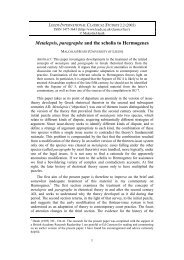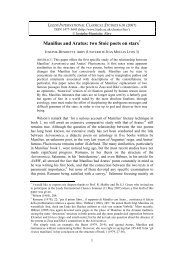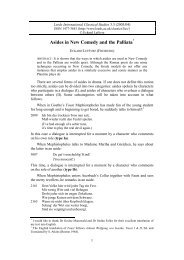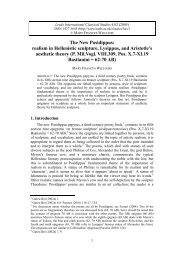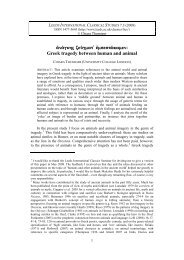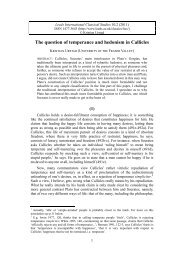Revisiting Tarpeia's myth in Propertius (IV, 4) - Leeds International ...
Revisiting Tarpeia's myth in Propertius (IV, 4) - Leeds International ...
Revisiting Tarpeia's myth in Propertius (IV, 4) - Leeds International ...
You also want an ePaper? Increase the reach of your titles
YUMPU automatically turns print PDFs into web optimized ePapers that Google loves.
MYRTO GARANI, REVISITING TARPEIA’S MYTH IN PROPERTIUS (<strong>IV</strong>, 4)<br />
euhoe Bacche fremens, solum te virg<strong>in</strong>e dignum<br />
vociferans: etenim mollis tibi sumere thyrsos, 390<br />
te lustrare choro, sacrum tibi pascere cr<strong>in</strong>em.<br />
Nay more, feign<strong>in</strong>g the spirit of Bacchus, essay<strong>in</strong>g a greater s<strong>in</strong> and launch<strong>in</strong>g a<br />
greater madness, she flies forth to the forest, and hides her daughter <strong>in</strong> the leafy<br />
mounta<strong>in</strong>s, <strong>in</strong> order by this means to rob the Teucrians of their marriage and<br />
delay the nuptial torch. ‘Evoe Bachhus!’ she shrieks. ‘You alone’, she shouts,<br />
‘are worthy of the maiden! It is for you, <strong>in</strong> truth, she takes up the wav<strong>in</strong>g<br />
thyrsus, to you she pays honour <strong>in</strong> the dance, for you she grows her sacred<br />
tresses.’<br />
talem <strong>in</strong>ter silvas, <strong>in</strong>ter deserta ferarum 404<br />
reg<strong>in</strong>am Allecto stimulis agit undique Bacchi<br />
So fares it with the queen, as amid woods, amid wild beasts’ coverts, Allecto<br />
drives her far and wide with Bacchic goad.<br />
While the other two hero<strong>in</strong>es were explicitly compared to Maenads, Amata<br />
pretends to become one and causes the women of the city to follow her, after her<br />
failed appeal to Lat<strong>in</strong>us not to give his daughter <strong>in</strong> marriage to Aeneas. 29 More to<br />
the po<strong>in</strong>t, by hurl<strong>in</strong>g a snake at Amata, a torch at Turnus and madness at Ascanius’<br />
dogs, Allecto causes the war to beg<strong>in</strong> (Aen. 7.475-510). And as has been well<br />
discussed, Allecto harks back to Ennius’ demonic Discordia taetra (fr. 225-226<br />
Sk.) or the Paluda virago (fr. 220 Sk.) who opens the Janus Gem<strong>in</strong>us at the<br />
outbreak of the Second Punic war and hurls Rome <strong>in</strong>to the chaos of war with<br />
Carthage <strong>in</strong> Annales 7. 30 This transition from peace to war <strong>in</strong> Roman history has<br />
been conv<strong>in</strong>c<strong>in</strong>gly connected by Ennius with the cyclic alternation between<br />
cosmic Love and Strife, and his Discordia taetra has been identified with the<br />
Empedoclean pr<strong>in</strong>ciple of Strife. 31 Allecto thus appears to be the Vergilian<br />
equivalent of the Empedoclean Strife.<br />
Return<strong>in</strong>g to <strong>Propertius</strong>’ poem, Tarpeia’s action <strong>in</strong>s<strong>in</strong>uates allusions to both<br />
Dido and Amata, the former be<strong>in</strong>g deceived by a goddesses who represents the<br />
power of love (Dido by Venus via Cupid: fallasque veneno, 1.688), the latter, on<br />
the contrary, by one who embodies the pr<strong>in</strong>ciple of strife (Amata by Juno via<br />
Allecto: fallitque furentem, 7.350). This allusion to Amata gives Tarpeia’s elegiac<br />
love a new twist and destabilizes the so far crystallized function of Vesta as<br />
<strong>in</strong>stigator of it. While the allusion to Vergil’s Venus underscores the elegiac aspect<br />
of Tarpeia who acts like Dido under the power of love, Vesta’s <strong>in</strong>tervention is also<br />
revealed to be conditioned by her <strong>in</strong>tertextual association with the Vergilian<br />
Allecto, the Empedoclean pr<strong>in</strong>ciple of Strife.<br />
At this po<strong>in</strong>t, the reader should recall that already <strong>in</strong> the course of her<br />
monologue, Tarpeia’s thoughts strik<strong>in</strong>gly alternate between love and warlike<br />
29 Nelis (2001) 290.<br />
30 For Vergil’s allusion to Ennius’ Discordia see Norden (1915) 18-33. Lucretius’ Venus and Mars<br />
should, of course, be considered Vergil’s other ma<strong>in</strong> <strong>in</strong>tertext for the latter’s reception of<br />
Empedoclean echoes. See now Hardie (2009) on Discordia and Vergil’s Fama.<br />
31 Norden (1915) 10-30; Bignone (1929) 22. The historical sett<strong>in</strong>g is probably the revolt of the<br />
Falerii, <strong>in</strong> 241 BC, provok<strong>in</strong>g the re-open<strong>in</strong>g of the Ianus Gem<strong>in</strong>us, which had been closed at the<br />
end of the First Punic War. See also Skutsch (1985) 394-6 and 403-4.<br />
8



